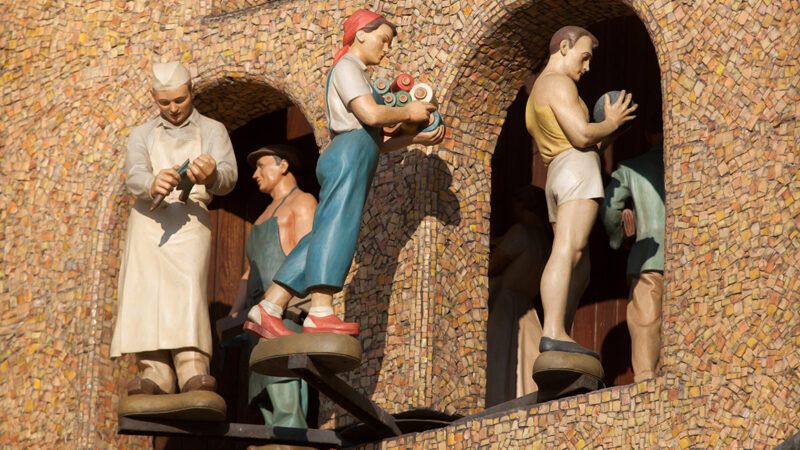A Czech Clock's Forgotten Pasts
The Olomouc clock's changing design reflects history's victors and their legacies.

There's a scene in Richard Linklater's 2004 film, Before Sunset, where protagonists Jesse and Céline drift past Notre Dame on a Paris riverboat. Taken by the cathedral's beauty, Jesse tells a story of its near-destruction. Occupying Nazis filled Notre Dame with explosives and intended to blow it up during World War II, he says, but the German soldier tasked with detonating the cathedral couldn't bring himself to do it.
"That's a great story. But you have to think that Notre Dame will be gone one day," Céline replies. "There used to be another church, a cathedral, at the same [spot]. Right there."
The story is exaggerated. But the lesson is on display in Olomouc, an ancient city tucked away in the leafy eastern Czech Republic. The inner city's crown jewel is a towering astronomical clock said to date back as far as the late 1400s or early 1500s. Destroyed and rebuilt many times in its history, the clock is a stark reminder that the artifacts we see are never guaranteed to be final. It's often said that "history is written by the victors." So is the art—and that can distort or limit our understanding of the places we visit.
The first face of Olomouc's astronomical clock is unknown. The second, following renovations in the 1570s, depicted a medieval view of the universe. It featured three spheres, a city information center pamphlet explains: the earthly, the celestial, and the heavenly. Following the 30 Years' War and with the phasing out of medieval ideas, depictions of the seven liberal arts decorated the clock alongside images of saints and royals. A renovation in the late 1800s reflected changing scientific knowledge, with the clock redesigned to mirror the heliocentric planetary system rather than the previously accepted Earth-centric one.
The clock suffered damage during World War II. The resulting renovation (put wryly by that pamphlet as "the final negation of the astronomical clock's lasting historical worth as an artistic monument") in the 1950s left only the clock mechanism intact, introducing socialist realist depictions of laborers, farmers, and blacksmiths. The updated clock also honors old communist holidays, including the dates of Vladimir Lenin's birth and Josef Stalin's death.
When the communist Czechoslovak regime fell and monuments of that era were removed, locals wondered what to do about the now-antiquated clock. There "came a question of legal precedent as to whether it would be possible to return the astronomical clock to a dignified appearance," the informational pamphlet explains. "Discussion was tabled at the very outset when the local Monuments Institution absolutely refused to consider the astronomical clock as a monument."
The clock, updated 70 years ago, is outdated once again. Rather than reminding onlookers of the virtues of a living, breathing regime, its face acts more as a gravestone, commemorating a long-abandoned state. The work, "in its own way, bears witness to a time which it would be advisable not to forget," the pamphlet notes.
Art and architecture are subject to government whims, acts of war, and the changeability of their creators and owners. Countless ancient Greek bronze statues were melted down long ago to make money, weapons, and other pieces of art. A 2022 X-ray of Vincent van Gogh's Head of a Peasant Woman (1885) revealed a self-portrait on the reverse, the famously poor artist often reusing canvases by working on the backside. The towering Frauenkirche in Dresden, Germany, looks today as it did in the 18th century, but only because the post–World War II reconstruction effort following its total destruction was based on original plans from the 1720s. An observer might not realize that so much has changed in the meantime.
The designers of Olomouc's astronomical clock had their sights set on the long term. They were "optimists," wrote the professional traveler Rick Steves. "The mechanism displaying the year is capable of spinning up to AD 9999."
The Long Now Foundation, a nonprofit dedicated to long-term thinking, is building a clock that will keep time for the next 10,000 years—a length of time about equal to the age of modern civilization. "If you have a Clock ticking for 10,000 years what kinds of generational-scale questions and projects will it suggest?" wrote Kevin Kelly, co-chair of Long Now's board of directors. "If a Clock can keep going for ten millennia, shouldn't we make sure our civilization does as well?"
The clock in Olomouc may have many more faces yet to come. Its beauty may be rediscovered, transformed, and lost again and again. But the mechanical core has remained constant for hundreds of years. If the current face represents the winning vision of a bygone era, the technology underneath represents a commitment to what comes next.


Show Comments (10)